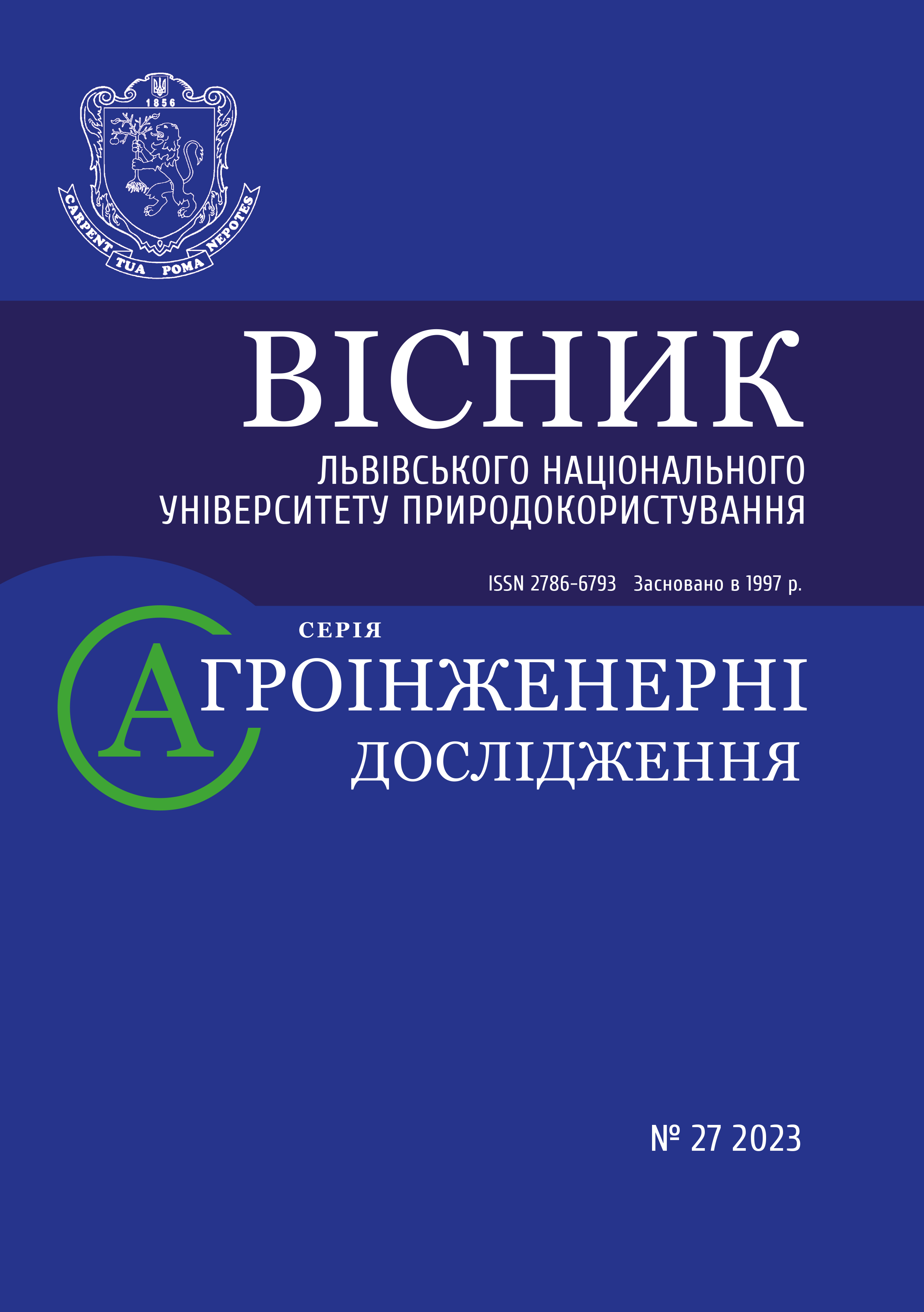Analysis of modern sensors and the feasibility of automated monitoring of feed consumption by pigs on farms
DOI:
https://doi.org/10.31734/agroengineering2023.27.043Keywords:
monitoring, automated processes, feed consumption, sensorsAbstract
An analysis was conducted on the process of automated monitoring of feed consumption by pigs on different farms to establish the peculiarities of the feed consumption process. Effective feeding management and optimal animal growth are based on these peculiarities. The feasibility of using modern sensors for automated monitoring of feed consumption by pigs was substantiated. The authors suggest using different types of sensors, including weight, movement, volume, and individual feed consumption sensors. The study established that image analysis methodology is preferred when using motion sensors to monitor feed consumption. Radio frequency identification (RFID) technology is recommended for monitoring individual feed consumption by pigs. RFID technology uses radio waves to read and capture information stored on a tag attached to the object. Each type of sensor has its advantages and disadvantages in terms of accuracy, reliability, cost, and ease of installation. Despite the shortcomings of existing sensors for automated monitoring of pig feed intake, they have significant advantages over manual feeding monitoring, including real-time data collection, increased accuracy, and reduced labor costs. The study defines the tasks that should be solved during the automated monitoring of fodder. Solving the main tasks can increase the accuracy of data collection and, accordingly, the efficiency of animal feeding. The study concludes that the use of modern sensors for automated monitoring of feed consumption has great potential for increasing the efficiency and profitability of pig farming. The choice of sensors for automated feed consumption monitoring systems significantly affects the efficiency and reliability of the systems and is a direction for further research.
References
Ahmed, S., Mun, H., Yoe, H., & Yang, C. (2015). Monitoring of behavior using a video-recording system for recognition of Salmonella infection in experimentally infected growing pigs. Animal, 9, 115-121.
Bekraoui, A., & Hadjadj, A. (2020). Thermal flow sensor used for thermal mass flowmeter. Microelectronics Journal, 103, 104871. doi: 10.1016/j.mejo.2020.104871.
Hryshchuk, O. V. (2021). Automated systems of control and management of pig feeding by applying modern technologies. Technology, energy, transport APK, 3, 16-19.
Kashiha, M. A., Bahr, C., Ott, S., Moons, C. P. H., Niewold, T. A., Tuyttens, F., & Berckmans, D. (2014). Automatic monitoring of pig locomotion using image analysis. Livestock Science. 159, 141–148.
Kashiha, M., Bahr, C., Haredasht, S. A., Ott, S., Moons, C. P., Niewold, T. A., Ödberg, F. O., & Berckmans, D. (2013). The automatic monitoring of pigs water use by cameras. Computers and Electronics in Agriculture. 90, 164–169.
Kovaliova, O. V. (2020). Development of the technologies of pig feeding by applying automatic systems of control for their feeding. Agrarian bulletin Black sea region, 4, 92-97.
Lao, F., Brown-Brandi, T., Stinn, J. P., Liu, K., Teng, G., & Xin, H. (2016). Automatic recognition of lactating sow behaviors through depth image processing. Computers and Electronics in Agriculture, 125, 56–62.
Li, D., Chen, Y., Zhang, K., & Li, Z. (2019). Mounting Behaviour Recognition for Pigs Based on Deep Learning. Sensors, 19, 4924.
Li, K., & Slattery, C. (2014). Electromagnetic Flow Meters Achieve High Accuracy in Industrial Applications. Analog Dialogue, 48-02.
Nasirahmadi, A., Edwards, S. A., & Sturm, B. (2017). Implementation of machine vision for detecting behaviour of cattle and pigs. Livestock Science, 202, 25-38.
Nasirahmadi, A., Hensel, O., Edwards, S. A., & Sturm, B. (2016). Automatic detection of mounting behaviours among pigs using image analysis. Computers and Electronics in Agriculture, 124, 295-302.
Nasirahmadi, A., Sturm, B., Edwards, S., Jeppsson, K.-H., Olsson, A.-C., Müller, S., & Hensel, O. (2019). Deep Learning and Machine Vision Approaches for Posture Detection of Individual Pigs. Sensors, 19, 37-38.
Rui, Ren, Hongliang, Wang, Xiaolei, Sun, & He, Quan. (2022). Design and Implementation of an Ultrasonic Flowmeter Based on the Cross-Correlation Method. Sensors, 22(19), 7470. doi: 10.3390/s22197470.
Savchenko, O. O., Kolomiiets, Yu. V., & Hlushchenko, O. V. (2019). Development of pig-raising technology in conditions of production process automation. Bulletin of Petro Vasylenko Kharkiv National Technical University of Agriculture. Series: Mechanization of agro-industrial production, 199, 166-173.
Shumylo, I. M., Parkhomenko, O. O., & Moroz, L. V. (2021). Automation of the technology of pig feeding by applying modern information technologies. Scientific bulletin of Polissia, 2 (16), 200-208.
Tkachuk, S. V., & Kozachenko, A. A. (2018). Automated systems of control for pig feeding parameters. Machinery and technology of food production, 4 (14), 1-7.
Tryhuba, A. M., & Sydorchuk, O. V. (2010). Peculiarities of planning the projects and programs of agrarian production. Project management: conditions and prospects: Proceedings of the 6th International conference, 313-316). Mykolaiv: NUK.
Tryhuba, A., & Bashynsky, O. (2019). Coordination of dairy workshops projects on the community territory and their project environment, International Scientific and Technical Conference on Computer Sciences and Information Technologies, 3, 51–54.
Tryhuba, A., Boyarchuk, V., Tryhuba, I., Ftoma, O., Francik, S., & Rudynets, M. (2020). Method and Software of Planning of the Substantial Risks in the Projects of Production of raw Material for Biofuel. CEUR Workshop Proceedings, 2565, 116-129.
Tryhuba, A., Tryhuba, I., Ftoma, O., & Boyarchuk, O. (2019). Method of quantitative evaluation of the risk of benefits for investors of fodder-producing cooperatives. 14th International Scientific and Technical Conference on Computer Sciences and Information Technologies (CSIT), 3, 55–58.
Yang, A., Huang, H., Zhu, X., Yang, X., Chen, P., Li, S., & Xue, Y. (2018). Automatic recognition of sow nursing behaviour using deep learning-based segmentation and spatial and temporal features. Biosystems Engineering, 175, 133–145.
Zheng, C., Zhu, X., Yang, X., Wang, L., Tu, S., & Xue, Y. (2018). Automatic recognition of lactating sow postures from depth images by deep learning detector. Computers and Electronics in Agriculture, 147, 51-63.
Тryhuba, А., Boyarchuk, V., Tryhuba, I., Ftoma, O., Padyuka, R., & Rudynets, M. (2020). Forecasting the Risk of the Resource Demand for Dairy Farms Basing on Machine Learning. Proceedings of the 2nd International Workshop on Modern Machine Learning Technologies and Data Science (MoMLeT+DS 2020), I, 327-340.


